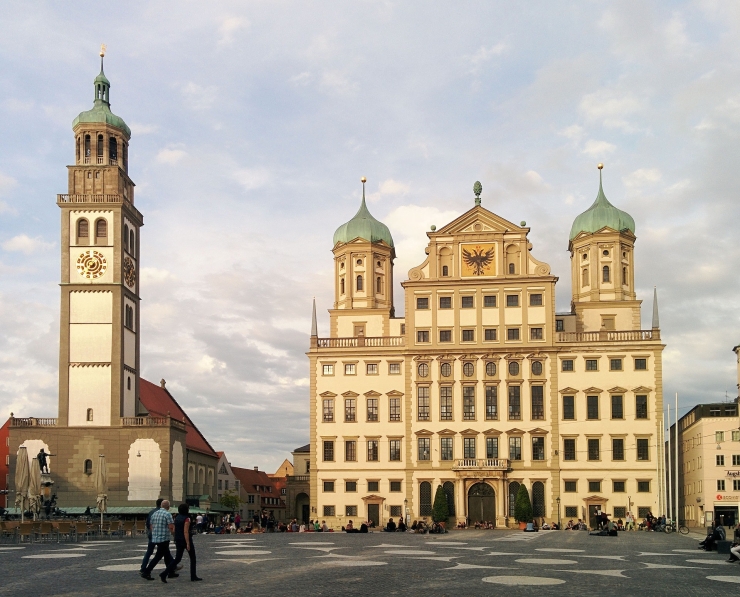In early September of 2018, just after Labor Day, we departed on our Southern Germany Tour. We timed our visit to take advantage of lower prices than in summer and weather that was still on the warmer side. German weather is always unpredictable, so we’d told our guests to pack layers and be prepared for some cooler, rainy days, especially in the mountains.

We were delighted to be greeted by summer-like weather and deep blue skies when we arrived at Lake Constance – or Bodensee in German – shared by Germany, Austria, and Switzerland. The lake, located at the intersection of main trade routes between France, Italy, and countries to the East, has a long and rich history. At the east end of the lake are spectacular views of the Swiss Alps, which seem to stretch all the way to the water.

Our destination was Constance – or Konstanz in German – a historic university town. Constance was the site of the Council of Constance in the 1600s, when a large multi-year convention was held by the Catholic church. Religious leaders met to choose between three popes, each claiming to be the rightful head of the Catholic church.
We explored the cobblestone streets of the old town lined by colorful stone houses, ate dinner outdoors in the town square in the midst of a local festival, and climbed to the top of the cathedral tower for exquisite views over the lake.

We explored tiny Reichenau Island and its three churches, including an ancient Benedictine abbey. A special treat awaited us for lunch as we dined on fresh vegetables grown on the island, along with local fish. Later, we explored the 1000-year old island of Mainau with its abundant gardens and butterfly house and had cake and coffee – a German tradition – at a café at the foot of the island’s Baroque palace.

At the end of our two days, we took one of the many ferries that transport cars, bikes, and pedestrians across the lake to Meersburg.

We climbed the town’s cobblestoned streets beneath the oldest still-inhabited medieval fortress in Germany and then found our way to Unteruhldingen where we were transported back to prehistoric times at the Pfahlbauten (or pole house) museum, a collection of “lake dwellings” reconstructed from remnants found in the lake. The houses, furnished with artifacts such as tools, pottery, and even furniture, paint a vivid picture of how the early lake dwellers lived.

Our next stop was Augsburg. Established by the Romans because of its strategic location for trade and defense, it is one of the oldest cities in Germany. The sun continued to shine – summer apparently had not left Germany – so we drove a route that took us in view of the mountains, stopping in Landsberg am Lech, located on the beautiful Lech River. The colorful Bavaria Gate tower – apparently the inspiration for the glockenspiel tower in Munich – immediately caught our eye.

Taking the passageway under “Beautiful Tower” (Schmalzturm), we walked into town down cobbled streets. The village’s pastel colored buildings seemed to glow in the late afternoon light.

We enjoyed a traditional Bavarian meal outdoors at an inn by the river. The town has a darker connection with WWII – Adolf Hitler wrote Mein Kampf while imprisoned there – but fortunately there is much more to Landsberg than that part of its history.
We reached our hotel in the historic center of Augsburg that evening. The next day was Sunday. Shops were closed and traffic was light. It felt like we had the town to ourselves. We wandered the city, filled with impressive buildings, among them the Renaissance town hall – or Rathaus in German – and found the spectacular golden room.

Of course, we enjoyed coffee and cake (Kaffee und Kuchen) at one of the many cafés on the main square, recommended by Henrike, a local German friend of Christiana’s, who joined us for the day. Like Constance, Augsburg was situated on an important trade route. It became very wealthy, has a long religious history, and was one of Germany’s most important cities during the Renaissance.
One of our favorite stops was the Fuggerei, the world’s oldest social housing complex, built in the 1500s. It was conceived and financed by Jacob Fugger, the wealthiest person (not including aristocrats) who has ever lived. Rent was – and still is – less than one dollar a year. The Fuggerei is open to Catholics who reside in Augsburg, never had money (or else lost what they did have), and can’t afford to make ends meet. The walled-enclave includes sixty or so small ivy-covered houses, all painted a golden yellow color, set on tranquil lanes. Inside, they are small but comfortable. The Fuggerei was heavily damaged in WWII and rebuilt. We visited the underground bunker and looked at the photographs that gave a sense of the cramped conditions and terror the people who used it must have felt.

In the late afternoon, we found our way back to our hotel via the city’s canals. Since the 10thcentury, Augsburg has used the water in the canals to generate power. The system of narrow waterways lined with footpaths and crossed by hundreds of bridges provided clean drinking water for Augsburg’s citizens at a time when water in most places was dirty and unsanitary. This historic water system is still in use today. We admired the small window boxes and tiny gardens tucked into corners and atop the stoops of the pretty houses edging the canals.

Until this point, we had been “off the beaten path.” Our next stop would put us squarely on it….to be continued.
